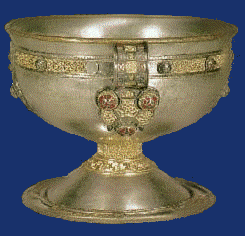
Ardagh Chalice
In September 1868, a young man
named Quin was digging potatoes at the south-western side of a Rath (fort)
called Reerasta, beside the village of Ardagh and near the Carrickerry
road. When he reached the bank close to a thorn bush he found the surface
soft, and driving his spade down between the roots of the thorn, he found
it strike something hard. He cleared away the earth and found a beautiful
cup now known as the Ardagh chalice. In the cup there was a smaller one
made of bronze and five fibulae.
There is nothing known of the history of this precious relic of a lost
art, or how it came to be buried in the Rath. It is suggested that it
is one of the valuable cups that were stolen from Clonmacnois, in the
year 1125, by a Limerick Dane, who was captured and hanged the following
year.
Tradition says that Mass used to be said in the Rath where they were
found, in the penal times. The chalice may have been used on these occasions
to distribute communion to the multitude that assembled there. Perhaps
when the alarm was given, and in the hurry of the moment, the chalice
were hidden to prevent them from falling into the wrong hands. This would
be supported by the condition in which they were found, there being no
case or covering to protect them suggests that they were buried in a hurry.
The priest or person who placed them in the earth, may never have had
an opportunity of returning to the place to retrieve them.
The Ardagh Chalice is considered to be the finest specimen of Celtic
art ever yet found. It has two handles and was probably used for the communion
of the laity when the Eucharist was administered under the species of
bread and wine. This cup, which combines classic beauty with the most
exquisite examples of almost every variety of Celtic orna- mentation,
is 7 inches high and 9.5 inches in diameter. The foot is 6.5 inches in
diameter, the depth of the bowl is 4.5. Inches; it would contain three
pints of liquid. It is composed of gold, silver, bronze, brass, copper,
and lead and comprises 354 pieces, including 20 rivets. There is a beautiful
band running round the outside of the bowl on which is engraved the names
of the twelve Apostles.
  
|